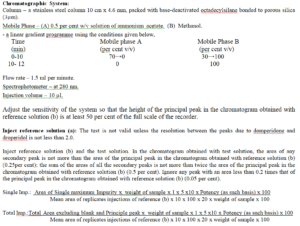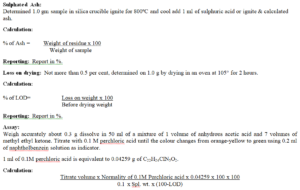standard testing procedure domperidone
Storage Requirements:
Store protected from light.
Sampling:
Sample equal quantity from each container / bag. Collect a minimum of 5g from each container/bag sample into individual, self –sealing polythene bag kept in another self sealing polythene bag bearing ‘Sample for analysis, label. After completion of sampling return rest sample on same container. Collect control sample in Pet Bottle/Glass Bottle.
Quantity of Composite Sample:
10 g
Quantity of individual Identification
0.0100 g from each and every container /bag.
Quantity of Control Sample:
2 X 10 g
Description: A white or almost white powder.
Solubility: Soluble in dimethylformamide; slightly soluble in ethanol (95per cent) and in methanol; practically insoluble in water.
Identification: By IR.
Appearance of solution: A 1.0% solution in dimethylformamide is clear (2.4.1) and not more intensely coloured than reference solution YS6.
Related Substances: Determine by liquid chromatography.
A. Single impurity: Not more than 0.25%.
B. Total impurity: Not more than 0.50%.
Heavy Metals: NMT 20ppm.
Sulphated Ash: NMT 0.10%w/w.
Loss on drying: NMT 0.5%w/w.
Assay: 99.0% to 101.0%w/w on the dried basis.
Description: A white or almost white powder.
Examine the individual samples by visually.
Reporting: Report as Complies/Does not comply.
Solubility: Soluble in dimethylformamide; slightly soluble in ethanol (95per cent) and in methanol; practically insoluble in water.
Reporting: Report as Complies/Does not comply.
Identification:
Determine by infrared absorption spectrophotometry. Compare the spectrum with that obtained with domperidone RS or with reference spectrum of domperidone.
Reporting: Report as Complies/Does not comply.
Appearance of solution: A 1.0% solution in dimethylformamide is clear (2.4.1) and not more intensely coloured than reference solution YS6
Reporting: Report as Complies/Does not comply.
Related Substances: Determine by liquid chromatography.
Test Solution: Dissolve 0.1 g of the substance under examination in dimethylformamide and dilute to 10.0 ml with the same solvent.
Reference Solution (a): A solution containing 0.01 per cent w/v of domperidone RS and 0.015 per cent w/v of droperidol RS in dimethylformamide.
Reference Solution (b): Dilute 1.0 ml of the test solution to 100 ml with dimethylformamide. Dilute 5.0 ml of the solution 20 ml with dimethylformamide.

Where,
Imp. = Impurity.
Heavy Metals:
Standard solution: Into a 50-ml Nessler cylinder pipette 1.0 ml of lead standard solution (20 ppm Pb) and dilute with water to 25 ml. Adjust with dilute acetic acid or dilute ammonia solution to a pH between 3.0 and 4.0, dilute with water to about 35 ml and mix.
Test solution: Weigh in a suitable crucible the 1.0 gm of the sample, add sufficient sulphuric acid to wet the sample, ignite carefully at a low temperature until thoroughly charred. Add to the charred mass: 2 ml of nitric acid and 5 drops of sulphuric acid and heat cautiously until white fumes are no longer evolved. Ignite, preferably in a muffle furnace, at 500º to 600º, until the carbon is completely burnt off. Cool, add 4 ml of hydrochloric acid, cover” digest on a water-bath for 15 minutes, uncover and slowly evaporate to dryness on a water-bath. Moisten the residue with 1 drop of hydrochloric acid, add 10 ml of hot water and digest for 2 minutes. Add ammonia solution drop wise until the solution is just alkaline to litmus paper, dilute to 25 ml with water and adjust with dilute acetic acid to a pH between 3.0 and 4.0. Filter, If necessary, rinse the crucible and the filter with 10 ml of water, combine the filtrate and washings in a 50-ml Nessler cylinder, dilute with water to about 35 ml and mix.
Procedure: To each of the cylinders containing the standard solution and test solution respectively add 10 ml of freshly
prepared hydrogen sulphide solution, mix, dilute to 50 ml with water, allow to stand for 5 minutes and view downwards over a white surface; the colour produced with the test solution is not more intense than that produced with the standard
solution.
Reporting: Report as ppm.

Reporting: Reporting as per %.
DOCUMENT CHANGE HISTORY
| Revision No. | Changes |
| 00 | First Time Prepare |
| 01 | Review and Revision of Standard Testing Procedure as per current I.P. & update the Format. |
Analysis of vitamin B1 B6 B2 Nicotinamide and sodium pentothenate Injection
Analysis for Nandrolone Decanoate injection
Analysis of Dicyclomine and Diclofenac sodium Injection
standard testing procedure of Fexofenadine and Phenylephrine suspension
standard testing procedure of Piroxicam Injection
STP of Fungal Diastase and Papain capsules
standard testing procedure PVC
standard testing procedure glass ampoule
Standard testing procedure of Iron Sucrose Injection
Standard testing procedure lactose
Standard testing procedure mefenamic acid
standard testing procedure domperidone
standard testing procedure flavour mixed fruit
standard testing procedure dicyclomine hydrochloride
Standard testing procedure honey pure
standard testing procedure dextromethorphan hydrobromide
standard procedure of levocarnitine injection
Analysis of Ivermectin Suspension
standard testing procedure artemether injection
standard testing procedure artemether injection
standard testing procedure Carbocisteine syrup
standard testing procedure Phytomenadione injection
standard testing procedure serratiopeptidase
standard testing procedure starch IP
standard testing procedure sucrose refined sugar
standard testing procedure titanium dioxide
standard testing procedure tramadol hydrochloride
standard testing procedure zinc sulphate
standard testing procedure croscarmellose sodium
standard testing procedure colour erythrosine supra
standard testing procedure magnesium hydroxide
standard testing procedure diclofenac sodium
standard testing procedure dibasic calcium phosphate
standard testing procedure cyanocobalamin
standard testing procedure cholecalciferol
standard testing procedure Calcium carbonate oyster shell powder
standard test procedure Calcium Citrate
standard testing procedure Bronopol
standard testing procedure Bromhexine Hydrochloride
Standard Testing Procedure diclofenac sodium injection
Standard Testing Procedure Drotaverine Hydrochloride injection
Standard Testing Procedure Tranexamic acid injection
standard test procedure paracetamol infusion
standard test procedure ofloxacin and ornidazole infusion
standard test procedure ornidazole injection
standard test procedure Ondansetron injection
standard test procedure dextrose injection
standard test procedure ciprofloxacin injection
STP and analysis method of Ammonium Chloride
Analysis method of aceclofenac
analysis method of Losartan Potassium and Hydrochlorothiazide
analysis method of Linezolid Dry Syrup
analysis method of Drotaverine Hydrochloride and Mefenamic acid
Analysis method of Ceftriaxone Sodium and Sulbactam sodium Injection
analysis method of Cefepime and Tazobactam Injection
Analysis method of Hydroquinone Cream
Analysis method of Tacrolimus Ointment
Analysis method of Terbinafine HCL Cream
Analysis method of Mometasone Furoate and Fusidic Acid Cream
Analysis method of Disodium Hydrogen Citrate Syrup
Analysis method of Hydroquinone with Tretinoin Cream
Analysis method of Hydroquinone Tretinoin and Mometasone Furoate Cream
Analysis method of Sertaconazole Nitrate Cream
Analysis method of Halobetasol Propionate Cream
Analysis method of Povidone Iodine with Ornidazole Ointment
Analysis method of Eberconazole Cream
Analysis method of Luliconazole Cream
Analysis method of Fluconazole Gel
Analysis method of Ketoconazole Cream
Analysis method of Salbutamol and Choline theophyllinate Syrup
Analysis method of Methylcobalamin Injection
Analysis method of Piroxicam and paracetamol Injection
Analysis method of Alpha Beta Arteether Injection
Analysis method of Enrofloxacin Suspension
Analysis method of Levetiracetam Syrup
Analysis method of Sucralfate suspension
Analysis method of Sucralfate and Oxetacaine Suspension
Analysis method of Quinine Sulphate Suspension
Analysis method of Calcium Carbonate vitamin D3 Zinc Gluconate and Magnesium hydroxide suspension
Analysis method of Suspension of Tribasic Calcium phosphate with vitamin D3 and Vitamin B12
Analysis method of Calcitriol with calcium citrate Suspension
Analysis method of Oxyclozanide and Fenbendazole Suspension
Analysis method of Oxyclozanide and Levamisole Suspension
Analysis method of Triclabendazole and Ivermectin Suspension
Analysis method of Itraconazole Solution
Analysis method of Levocetirizine Dihydrochloride syrup
Analysis method of Iron Calcium Vitamin D3 Folic Acid Vitamin B12 Suspension
Analysis method of Ferrous Ascorbate Cyanocobalamin and Folic Acid Suspension
Analysis method of Ambroxol Hydrochloride Drops
Analysis method of Ferrous Ascorbate with Folic Acid suspension
Analysis method of Piracetam Syrup
Analysis method of Rafoxanide and Levamisole suspension
Analysis method of Zinc gluconate Syrup
Analysis method of Magaldrate Simethicone and Oxetacaine suspension
Analysis method of mefenamic acid and paracetamol suspension
Analysis method of Cholecalciferol Drops
Analysis method of Racecadotril suspension
Analysis method of Deflazacort Suspension
Analysis method of Montelukast sodium and levocetirizine Dihydrochloride Syrup
Analysis method of Iron and Folic Acid Syrup
Analysis method of Cyproheptadine Hydrochloride and Tricholine Citrate Syrup
Analysis method of Levofloxacin Hemihydrate Ornidazole and Vitamin E Solution
Analysis method of Albendazole and ivermectin in oral liquid
END OF DOCUMENT